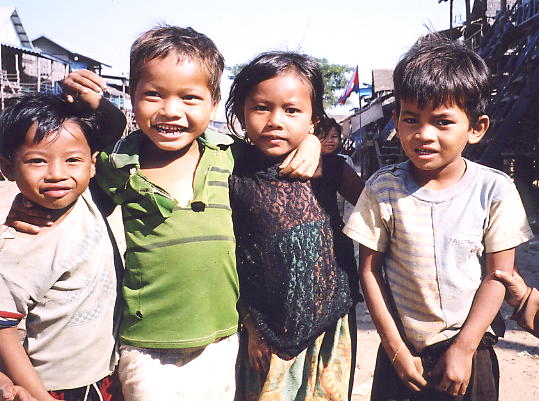
ANDYBROUWER.CO.UK
CAMBODIA TALES 2005 - JANUARY
Kompong Phluk
 Day three began with
scrambled eggs and coffee for breakfast at the HanumanAlaya and
the arrival of the 4WD with Rieng and Heng at 8am. Today's outing
was supposedly a non-temple location, namely Kompong Phluk,
described variously as a floating village and a submerged forest,
some ten kilometres south of the Roluos group of temples. I'd
previously spent time in and around the lakeside village of Chong
Khneas, the most popular floating village closest to Siem Reap,
but Kompong Phluk was getting 'good press' from a few people in
the know, so it
Day three began with
scrambled eggs and coffee for breakfast at the HanumanAlaya and
the arrival of the 4WD with Rieng and Heng at 8am. Today's outing
was supposedly a non-temple location, namely Kompong Phluk,
described variously as a floating village and a submerged forest,
some ten kilometres south of the Roluos group of temples. I'd
previously spent time in and around the lakeside village of Chong
Khneas, the most popular floating village closest to Siem Reap,
but Kompong Phluk was getting 'good press' from a few people in
the know, so it  was time to see for
myself. Both of my companions had been before and promised me an
enjoyable trip. I was looking forward to it, and wouldn't be
disappointed.
was time to see for
myself. Both of my companions had been before and promised me an
enjoyable trip. I was looking forward to it, and wouldn't be
disappointed.
Ninety minutes later, we'd
reached Kompong Phluk after an engaging journey worthy of 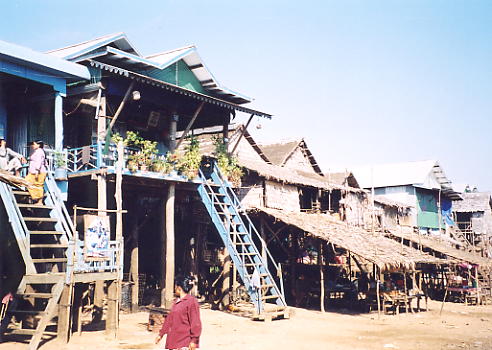 mention. The road from Siem Reap to Roluos is in
excellent shape these days and its almost as good as you reach
Roluos town itself. With the busy early morning street market in
full flow right across our path, our progress was reduced to a
crawl through the town centre until we left the tree-lined
streets behind and joined the raised sandy track heading toward
the Tonle Sap Lake off into the distance. For most of the wet
season, the fields either side of the road are
mention. The road from Siem Reap to Roluos is in
excellent shape these days and its almost as good as you reach
Roluos town itself. With the busy early morning street market in
full flow right across our path, our progress was reduced to a
crawl through the town centre until we left the tree-lined
streets behind and joined the raised sandy track heading toward
the Tonle Sap Lake off into the distance. For most of the wet
season, the fields either side of the road are 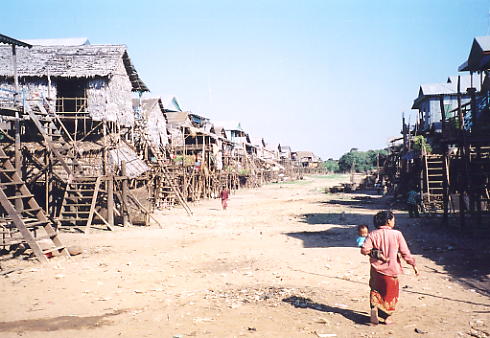 underwater and so rice
is grown in abundance as the water recedes. We spied a variety of
birds in the muddy stream flowing alongside us but few people as
our 4WD came into its own along the challenging track, which Heng
negotiated like a true professional. We passed a Camry stuck in
deep mud and all agreed that only a 4WD, moto and ox-cart could
make this trip. After an hour, we reached the end of the track, a
busy dock with small motorised boats waiting to take passengers
the final couple of kilometres along the Roluos river to the
village itself. We parked the 4WD and took our places in a boat
with half a dozen locals and a selection of bicycles, chickens
and market produce. It cost 1,000 riel each and the final leg of
our trip took a little over ten minutes.
underwater and so rice
is grown in abundance as the water recedes. We spied a variety of
birds in the muddy stream flowing alongside us but few people as
our 4WD came into its own along the challenging track, which Heng
negotiated like a true professional. We passed a Camry stuck in
deep mud and all agreed that only a 4WD, moto and ox-cart could
make this trip. After an hour, we reached the end of the track, a
busy dock with small motorised boats waiting to take passengers
the final couple of kilometres along the Roluos river to the
village itself. We parked the 4WD and took our places in a boat
with half a dozen locals and a selection of bicycles, chickens
and market produce. It cost 1,000 riel each and the final leg of
our trip took a little over ten minutes.
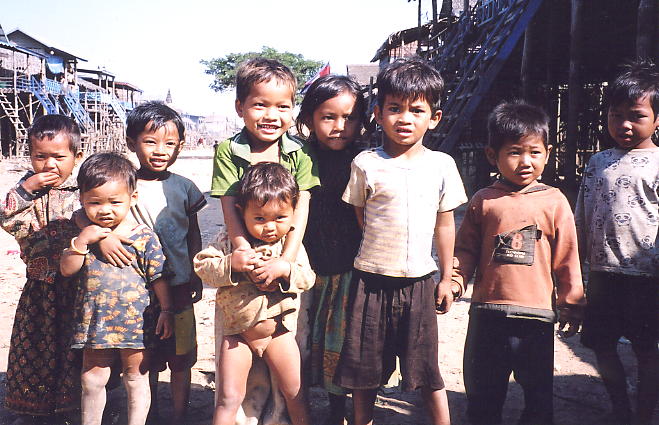 As we rounded a bend in
the river, the outskirts of the village came into view and was
quite a dramatic sight to behold. Rather than a floating village
in the Chong Khneas style, the houses of Kompong Phluk are built
on top of wooden poles and stilts between six and eight metres
high and tower over the boats moored along the river, which
snakes through the village before heading out into the Tonle Sap
lake. Behind the
As we rounded a bend in
the river, the outskirts of the village came into view and was
quite a dramatic sight to behold. Rather than a floating village
in the Chong Khneas style, the houses of Kompong Phluk are built
on top of wooden poles and stilts between six and eight metres
high and tower over the boats moored along the river, which
snakes through the village before heading out into the Tonle Sap
lake. Behind the 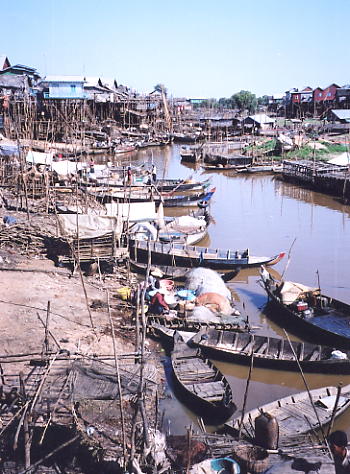 riverside homes are
more wooden houses on stilts, which are permanent residences
during the wet season and then only accessible by boat. However,
today, the village 'high street' was bone dry and reminded me of
a film-set from a wild west movie, without the ubiquitous saloon
and gunslingers. We left the boat and walked along the street to
a chorus of "hello, goodbye" from pockets of small
children, playing games beneath their homes and who eagerly lined
up for group photos and a game of football with a punctured ball.
We stopped at various points to watch fishing nets being mended,
tiny fish
riverside homes are
more wooden houses on stilts, which are permanent residences
during the wet season and then only accessible by boat. However,
today, the village 'high street' was bone dry and reminded me of
a film-set from a wild west movie, without the ubiquitous saloon
and gunslingers. We left the boat and walked along the street to
a chorus of "hello, goodbye" from pockets of small
children, playing games beneath their homes and who eagerly lined
up for group photos and a game of football with a punctured ball.
We stopped at various points to watch fishing nets being mended,
tiny fish 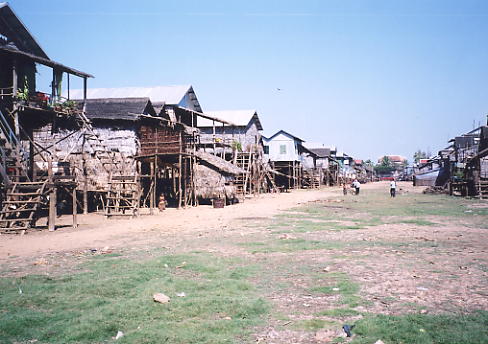 being dried on mats or
smoked over charcoal, masses of pink shrimp left to dry in the
sun and two women, with their bicycles laden with clothes for
sale, surrounded by small groups of women negotiating loudly. In
the pagoda at the far end of the street, the monks were painting
and repairing a wall and behind the wat, schoolchildren were
enjoying a break from their lessons, with a notable increase in
the noise level when I walked within earshot. I was informed by a
friendly monk that this part of the village is the only dry area
during the wet season. I found the village to be full of smiling
faces and genuine welcomes, without a hint of the tourist
trappings you find elsewhere in and around Siem Reap. We were
told by one of the villagers that Kompong Phluk is made up of
three fishing communities and nearly 3,000 people live there,
though many follow the fish onto the lake at this time of year,
explaining why the streets weren't as busy as I'd expected.
being dried on mats or
smoked over charcoal, masses of pink shrimp left to dry in the
sun and two women, with their bicycles laden with clothes for
sale, surrounded by small groups of women negotiating loudly. In
the pagoda at the far end of the street, the monks were painting
and repairing a wall and behind the wat, schoolchildren were
enjoying a break from their lessons, with a notable increase in
the noise level when I walked within earshot. I was informed by a
friendly monk that this part of the village is the only dry area
during the wet season. I found the village to be full of smiling
faces and genuine welcomes, without a hint of the tourist
trappings you find elsewhere in and around Siem Reap. We were
told by one of the villagers that Kompong Phluk is made up of
three fishing communities and nearly 3,000 people live there,
though many follow the fish onto the lake at this time of year,
explaining why the streets weren't as busy as I'd expected.
Heng had gone to find a boat
to take us to the submerged mangrove forest near the edge of the
lake, a 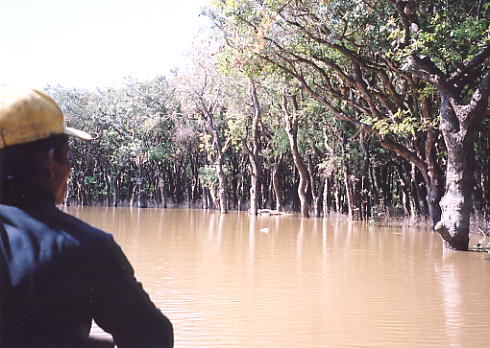 kilometre or so
upstream and at 10am we boarded a long canoe, with our oarsmen Ty
and Mok, stationed at either end. We paused at a large crocodile
pen and next to it a pig pen and to watch a family emptying their
fishing nets of their morning catch before we paddled out of the
village and along the river towards the forest. Ty pointed out
various birds and their calls as we entered the forest and told
us he regularly sees monkeys in the tree tops. At this time of
year, the water is between 3-4 metres deep as we weaved a path
between the trees, occasionally catching the oars in fishing nets
strung between tree trunks, though Ty took great care to untangle
us before moving on. Our lazy and peaceful meandering, exploring
various 'paths' deep into the forest as well as a visit to the
choppier waters at the edge
kilometre or so
upstream and at 10am we boarded a long canoe, with our oarsmen Ty
and Mok, stationed at either end. We paused at a large crocodile
pen and next to it a pig pen and to watch a family emptying their
fishing nets of their morning catch before we paddled out of the
village and along the river towards the forest. Ty pointed out
various birds and their calls as we entered the forest and told
us he regularly sees monkeys in the tree tops. At this time of
year, the water is between 3-4 metres deep as we weaved a path
between the trees, occasionally catching the oars in fishing nets
strung between tree trunks, though Ty took great care to untangle
us before moving on. Our lazy and peaceful meandering, exploring
various 'paths' deep into the forest as well as a visit to the
choppier waters at the edge  of the lake, lasted
for a little over an hour and cost just 10,000 riel - a bargain
in my view. We were dropped off at the village's farthest point
which allowed us to walk its whole length back to our starting
point, where we jumped aboard a larger, motorised taxi-boat for
the return trip to the boat dock and our 4WD, arriving at midday.
At the half-way point on the track back to Roluos, we stopped to
eat our lunch in a rest hut on stilts next to three houses and a
broken
of the lake, lasted
for a little over an hour and cost just 10,000 riel - a bargain
in my view. We were dropped off at the village's farthest point
which allowed us to walk its whole length back to our starting
point, where we jumped aboard a larger, motorised taxi-boat for
the return trip to the boat dock and our 4WD, arriving at midday.
At the half-way point on the track back to Roluos, we stopped to
eat our lunch in a rest hut on stilts next to three houses and a
broken 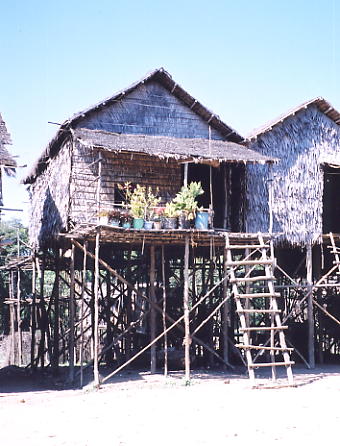 bridge. Chicken,
vegetables and rice, washed down by ice-cold water and a pleasant
breeze was spot-on. We reached Roluos at 1.30pm and crossed Route
6 at Angkram, heading north towards Chan Sar commune and a temple
that Heng had visited whilst working for an NGO the previous
summer. At the village of Srath, Rieng pointed out a school where
he'd spent two days in 2003, guarding election ballot boxes as
part of his primary job as a policeman. Half an hour later, we
reached the village of Sanloang and in the grounds of the village
wat stood Prasat Andet, a large brick tower and a smaller brick
library, most likely from the 10th century. Devoid of any
carvings and home to a family of bats, the doorway retained a
colonette and unfinished lintel as well as the remains of a
porch, whilst a miniature temple antefix was perched precariously
on a corner of an upper level. Four pedestals and a lotus bud
from the summit of the temple were lying in the shade nearby,
next to a forlorn-looking monkey on a lead.
bridge. Chicken,
vegetables and rice, washed down by ice-cold water and a pleasant
breeze was spot-on. We reached Roluos at 1.30pm and crossed Route
6 at Angkram, heading north towards Chan Sar commune and a temple
that Heng had visited whilst working for an NGO the previous
summer. At the village of Srath, Rieng pointed out a school where
he'd spent two days in 2003, guarding election ballot boxes as
part of his primary job as a policeman. Half an hour later, we
reached the village of Sanloang and in the grounds of the village
wat stood Prasat Andet, a large brick tower and a smaller brick
library, most likely from the 10th century. Devoid of any
carvings and home to a family of bats, the doorway retained a
colonette and unfinished lintel as well as the remains of a
porch, whilst a miniature temple antefix was perched precariously
on a corner of an upper level. Four pedestals and a lotus bud
from the summit of the temple were lying in the shade nearby,
next to a forlorn-looking monkey on a lead.
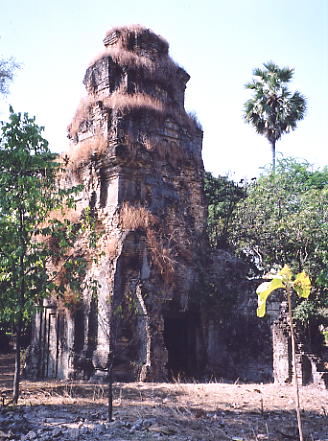 On our return to Siem
Reap, we stopped for half an hour at the extensive wat behind the
market at Damdek to visit the ruins of Prasat Banteay Srei.
Surrounded by a moat, the temple is deceptively large with two
entry gopuras in the outer enclosure wall, two broken libraries
and a central sanctuary with four entrance gates, a surrounding
gallery and a handful of defaced lintels, the best of which
sports a kala monster munching on a naga. Back at the
HanumanAlaya, I called my wife in England, a few friends
in-country and was asked by Sina, the receptionist, if I would
move to their other guesthouse nearby so they could accommodate a
party
On our return to Siem
Reap, we stopped for half an hour at the extensive wat behind the
market at Damdek to visit the ruins of Prasat Banteay Srei.
Surrounded by a moat, the temple is deceptively large with two
entry gopuras in the outer enclosure wall, two broken libraries
and a central sanctuary with four entrance gates, a surrounding
gallery and a handful of defaced lintels, the best of which
sports a kala monster munching on a naga. Back at the
HanumanAlaya, I called my wife in England, a few friends
in-country and was asked by Sina, the receptionist, if I would
move to their other guesthouse nearby so they could accommodate a
party 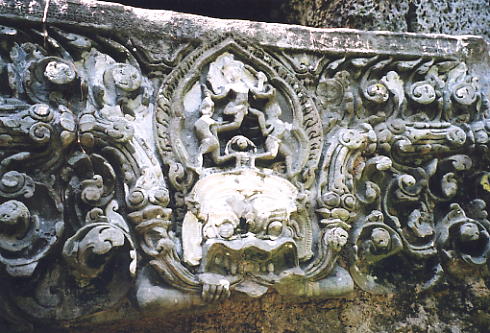 arriving tomorrow from
the television channel Discovery, in Cambodia to film a tv
documentary. Not a problem, I'd stayed there before and it's just
as good. I took a moto to the old market and spent an hour in the
internet cafe for the ridiculously low price of 2,000 riel, where
I bumped into Paul and Sheila Hay, the couple who run the Hidden
Cambodia adventure company and good friends of mine. They invited
me to their home to meet a group of dirt-bike riders who'd just
returned from a six-day trip and were having a goodbye party. How
could I refuse. After an enjoyable meal at the Red Piano, I
turned up at the Hay residence, just off the road heading towards
Angkor, for a chat with Paul and Sheila and an assortment of
nationalities, fresh from their trip around northern Cambodia,
watched their video and enjoyed the comraderie of a group who'd
grown close to each other in the past week. I left them as they
sat down for their late meal and was in bed by 10pm - early
nights in Cambodia allow for an early start the following
morning.
arriving tomorrow from
the television channel Discovery, in Cambodia to film a tv
documentary. Not a problem, I'd stayed there before and it's just
as good. I took a moto to the old market and spent an hour in the
internet cafe for the ridiculously low price of 2,000 riel, where
I bumped into Paul and Sheila Hay, the couple who run the Hidden
Cambodia adventure company and good friends of mine. They invited
me to their home to meet a group of dirt-bike riders who'd just
returned from a six-day trip and were having a goodbye party. How
could I refuse. After an enjoyable meal at the Red Piano, I
turned up at the Hay residence, just off the road heading towards
Angkor, for a chat with Paul and Sheila and an assortment of
nationalities, fresh from their trip around northern Cambodia,
watched their video and enjoyed the comraderie of a group who'd
grown close to each other in the past week. I left them as they
sat down for their late meal and was in bed by 10pm - early
nights in Cambodia allow for an early start the following
morning.
Here's links to the rest of my Cambodia Tales.
January 2005 marked my eleventh trip to Cambodia since my first-ever visit in 1994. It's a country that has a special magic all of its own and which draws me back every year to venture out into the Cambodian countryside in search of new adventures, ancient temples and to catch up with the friends I've made from previous visits. Each trip is full of laughter, smiles and a host of fresh experiences and my latest expedition was no exception.
Home : Next : Messageboard : 2005 : E-mail
The contents of this website cannot be reproduced or copied without permission of the site author. (c) Andy Brouwer 2005
Click to enlarge all photos. Click 'refresh' if photos do not fully load.